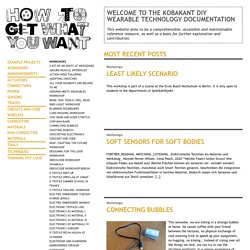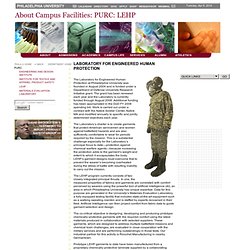

Central Saint Martins College MA Textile Futures. Smart Textiles. Shimmer - Wireless Sensor Platform for Wearable Applications. Fibretronic Limited: The World's Leading Supplier of Wearable Electronic Products and Technology Solutions. HOW TO GET WHAT YOU WANT. Welcome to the KOBAKANT DIY Wearable Technology Documentation Workshops least likely scenario This workshop is part of a course at the Ernst Busch Hochschule in Berlin.

It is only open to students in the departments of Spiel&&Objekt. Workshops soft sensors for soft bodies FURTHER_READING_WATCHING_LISTENING_ Elektronische Textilien als Material und Werkzeug_ Hannah Perner-Wilson, Irene Posch, 2020 “Welche Fasern leiten Strom? Workshops connecting bubbles This semester, we are sitting in a strange bubble at home. Sensors 6 really wearable sensors The textile sensors on our website are often not designed to be manipulated with your hands. Workshops soft interactive technologies This workshop is a part of a course at the Art Academy Weissensee Berlin. Workshops ETextile Adventures This workshop is part of a course at the Ernst Busch Hochschule in Berlin. Sensors Sole Sensing Rather simple way of making insoles with 3 pressure sensors located at different pressure points of the foot on the ground. Diffus: Home. Intelligent Clothing - Wearable Electronics, Smart Clothes, Smart Fabrics, Wearable Tech.
New Dynamics of Ageing. The design for ageing well project will focus on bringing emerging wearable technologies to active members of older age groups who do not suffer from restrictive medical conditions.

The proposal will address “Ageing well across the lifecourses: autonomy and independence” with a multi-disciplinary team incorporating researchers from technical textiles, wearable electronics and Information and Communication Technologies (ICT), and social and care sectors, with active participation from the users. Project Summary Investigator(s) Jane McCann, University of Wales Newport Team Stephen Benton, University of WestminsterTracey Williamson, University of Salford Julia Ryan, University of Salford Jennifer Bougourd, University of Wales NewportVikki Haffenden, University of BrightonChristopher Nugent, Ulster University Contact details Jane McCann Background We are at the beginning of a new industrial revolution with the merging of technical textiles, wearable electronics and ICT. Aims/objectives Design Links.
A Design Process for the Research and Development of Smart Clothes with Embedded Technologies with Potential to Enhance Quality of Life for Older People. Smart Clothes Wearable Technology Research Centre. Fluid Interfaces.
Nano-tera. Laboratory for Engineered Human Protection at Philadelphia University. The Laboratory for Engineered Human Protection at Philadelphia University was founded in August 2004 and is funded under a Department of Defense University Research Initiative grant.

The grant has been renewed each year and the Laboratory is currently funded through August 2008. Additional funding has been appropriated in the DoD FY 2008 spending bill. Work is carried out under a contract with the Natick Soldier Center, Natick MA and modified annually to specific and jointly determined objectives each year. The Laboratory’s charter is to create garments that protect American servicemen and women against battlefield hazards and are also sufficiently comfortable to wear for periods required by the mission. This is a substantial challenge especially for the Laboratory’s principal focus to date—protection against chemical warfare agents—because increasing the protection adds to the garment’s weight and extent to which it encapsulates the body. SubTela Home. High-Low Tech. XS. E-Textile Research Lab. E-Textiles Lab Advancing research in e-textiles. What are E-Textiles? Electronic textiles (e-textiles) are fabrics that have electronics and interconnections woven into them, with physical flexibility and size that cannot be achieved with existing electronic manufacturing techniques.
Components and interconnections are intrinsic to the fabric and thus are less visible and not susceptible to becoming tangled together or snagged by the surroundings. An e-textile can be worn in everyday situations where currently available wearable computers would hinder the user. Funding This material is based upon work supported by the National Science Foundation under Grant No. Washington Post feature on E-Textile Lab ECE's E-textile lab was featured in the Washington Post's Health Section on October 9, 2007 "E-Textiles" May Give "Custom Tailoring" New Meaning Eleventh IEEE International Symposium on Wearable Computers (ISWC 2007) October 11-13, 2007 - Boston, MA ISWC 2007 Web Site E-Textiles Lab on TV news.